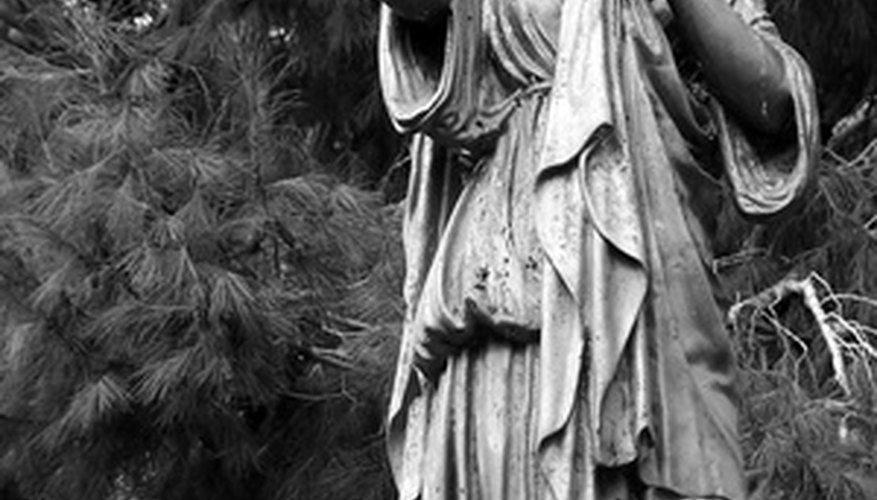Many children are familiar with Roman costumes from gladiators or soldiers they see on TV shows. In daily life, Roman clothing for both men and women were simple garments mostly made of draped fabric, with children wearing miniature versions of their parents. Plan a Roman costume for history-loving kids for a school report or a Halloween costume.
Roman Boy
Roman men dressed simply, wearing a white toga over a tunic. Young Roman boys traditionally wore the same, with the addition of a bulla, a round container worn on a chain around the neck. Designed to carry an amulet, the bulla for wealthy sons was made of gold while poor children wore a leather bulla. You can achieve the look of the simple short-sleeved tunic a boy might have worn starting with a white T-shirt. A sheet cut to the child's size and held together with safety pins makes the rest of the tunic. Tunics of wealthier children also displayed the clavus, two purple bands stretching down the front and back. The toga varied in design throughout history but was a wrap covering the tunic, with different decorations to identify the wearer's status. While men wore thick sandals on their feet, warm socks will help keep legs warm on an October night.
- Roman men dressed simply, wearing a white toga over a tunic.
- Designed to carry an amulet, the bulla for wealthy sons was made of gold while poor children wore a leather bulla.
Roman Girl
Young Roman girls dressed like their mothers, who wore a simple white tunic worn under a stola with a palla, or wrap. A child's tunic, like a Greek chiton, was short-sleeved and loosely gathered, with a thin belt at the waist and a diagonal strip of white fabric across the chest. Her costume begins with a white T-shirt covered by a piece of sheet with a hole cut for the head and a narrow belt. Older girls wore a white palla draped over the tunic, which you can create by draping a sheet over the shoulder and securing it with safety pins. Hair was drawn up and kept close to the head, with sandals on the feet. When travelling, girls wore a paenula, a hooded cloak that ended mid-calf intended to protect against the weather, an ideal garment for Halloween night. Wear a blanket pinned under the chin to create the paenula.
- Young Roman girls dressed like their mothers, who wore a simple white tunic worn under a stola with a palla, or wrap.
- Older girls wore a white palla draped over the tunic, which you can create by draping a sheet over the shoulder and securing it with safety pins.
Roman Soldier
The Roman soldier's costume should begin with a white T-shirt under a leather-like vest or faux metal armour. You can achieve the look of armour by making a breastplate of corrugated cardboard covered in foil. Soldiers sometimes wore a leather skirt resembling a kilt with arm bands and wrist bands. For trick-or-treating, dress your young soldier in a flesh- or light-coloured long-sleeved T-shirt for warmth beneath the arm bands. The soldier sometimes wore a metal helmet, which can also be made with foil-covered cardboard, or a leather strip around the forehead. On a cool night outdoors a small blanket fastened with a safety pin at the neck makes a perfect cloak for a soldier.
- The Roman soldier's costume should begin with a white T-shirt under a leather-like vest or faux metal armour.
